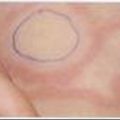7.9 Hepatitis
Aetiology
Halothane
Phenytoin
Erythromycin
Oestrogens
Androgens
Anabolic steroids
Hepatitis B1–3,6,10–12
Chronic hepatitis
1 Australian Government. Department of Health and Aging. National Health and Medical Research Council. Hepatitis A and B. The Australian Immunisation Handbook, 9th ed.. 2008. Available from http://www.health.gov.au/internet/immunise/publishing.nsf/Content/Handbook-home [accessed 15.10.10]
2 American Academy of Pediatrics. Hepatitis A–E. 2006 Red Book: Report of the Committee on Infectious Diseases, 27th ed. Elk Grove Village, IL: American Academy of Pediatrics. 2006:326-361.
3 Balistreri W.F. Part XVII The digestive system. Section 6. The liver and biliary system. In: Kliegman R.M., Behrman R.E., Jenson H.B., Stanton B., editors. Nelson’s Textbook of Pediatrics. 18th ed. Philadelphia: Saunders Elsevier; 2007:1657-1713.
4 Denson L.A. Other viral infections. In: Kleinman R.E., Goulet O.-J., Mieli-Vergani G., et al, editors. Walker’s Pediatric Gatrointestinal Disease. Ontario, Canada: BC Decker, Hamilton; 2008:859-864.
5 Harris W. Chapter 8. Gastroenterology. Examination Paediatrics. 4th ed. Chatswood, NSW: Elsevier Australia; p. 190–252
6 Australian Government. Department of Health and Aging. National Health and Medical Research Council. National Immunisation Program Schedule. Available from http://www.immunise.health.gov.au/internet/immunise/publishing.nsf/Content/E875BA5436C6DF9BCA2575BD001C80BF/$File/nip-schedule-card-july07.pdf [accessed 15.10.10]
7 Koff R.S. Hepatitis A. Lancet. 1998;351:1643-1691.
8 Hanna J.N., Hills S.L., Humphreys J.L. Impact of hepatitis A vaccination of Indigenous children on notifications of hepatitis A in north Queensland. Med J Aust. 2004;181:482-485.
9 Van Damme P., Banatvala J., Fay O., et al. Hepatitis A booster vaccination: is there a need? Lancet. 2003;362:1065-1071.
10 Mast E., Mahoney F., Kane M.A., Margolis H.S. Hepatitis B vaccine. In Plotkin S.A., Orenstein W.A., editors: Vaccines, 4th ed., Philadelphia, PA: Saunders, 2004.
11 Gill J.S., Bucens M., Hatton M., et al. Markers of hepatitis B virus infection in schoolchildren in the Kimberley, Western Australia. Med J Aust. 1990;153:34-37.
12 Aggarwal R., Ranjan P. Preventing and treating hepatitis B infection. Br Med J. 2004;329(7474):1080-1086. Review
13 Maheshwari A., Ray S., Thuluvath P.J. Acute hepatitis C. Lancet. 2008;372(9635):321-332. Review
14 Kesson A.M. Diagnosis and management of paediatric hepatitis C virus infection. J Paediatr Child Health. 2002:213-218.
15 Ryan M., Desmond P. Liver toxicity: could this be a drug reaction. Aust Fam Physician. 2001;30:427-431.
Australian Government. Department of Health and Aging. National Health and Medical Research Council. The Australian Immunisation Handbook, 9th ed.. 2008. Available from http://www.health.gov.au/internet/immunise/publishing.nsf/Content/Handbook-home (accessed 15.10.10)
American Academy of Pediatrics. Red Book: Report of the Committee on Infectious Diseases, 27th ed,. Elk Grove Village, IL: American Academy of Pediatrics; 2006.
Kleinman R.E., Goulet O.-J., Mieli-Vergani G., et al, editors. Walker’s Pediatric Gatrointestinal Disease. Ontario, Canada: BC Decker, Hamilton, 2008.










